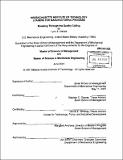Massachusetts Institute of Technology Leaders for Manufacturing Program : breaking throught the quality ceiling
Author(s)
Delisle, Lynn S. (Lynn Susan), 1968-
DownloadFull printable version (30.21Mb)
Alternative title
MIT LMP : breaking throught the quality ceiling
Other Contributors
Massachusetts Institute of Technology. Dept. of Mechanical Engineering.
Advisor
Stephen C. Graves and Daniel E. Whitney.
Terms of use
Metadata
Show full item recordAbstract
This thesis analyzes the challenges of change management in a US auto plant. The change initiative used as an example is the launch and implementation of quality recording and reporting software in a body assembly area. A more complete examination of this change initiative using the three lenses of organizational design shows that this plant has reached a quality ceiling based on its strategic design, culture, and political power structure. Breaking through the quality ceiling requires a change agent who harnesses the strengths of an organization to bring it to the next level of quality. Deeper analysis of the recommendations that come from the three lens analysis leads to the conclusion that a more integrated approach is needed to address the issues of change management in a mature organization. Change management strategies depend on the nature of the change, but also the leadership characteristics of the change agent. Three change management strategies are proposed: (1) planting the seeds of change within the organization by bringing in outsiders; (2) "awakening" members of the organization to the need for change; and (3) creating a crisis of a magnitude that members of the organization fear that not making the change is worse than accepting the change. A more integrated approach to change management using a strategy that complements the change agent's strengths will lead to the long-term success in continuous quality improvement. In conclusion, breaking through the quality ceiling requires a change agent who uses a change management approach that harnesses the strengths of the organization and leads it to the next level of quality.
Description
Thesis (S.M.)--Massachusetts Institute of Technology, Sloan School of Management; and, (S.M.)--Massachusetts Institute of Technology, Dept. of Mechanical Engineering, 2001. Includes bibliographical references (leaves 67-68).
Date issued
2001Department
Massachusetts Institute of Technology. Department of Mechanical Engineering; Sloan School of ManagementPublisher
Massachusetts Institute of Technology
Keywords
Sloan School of Management., Mechanical Engineering.